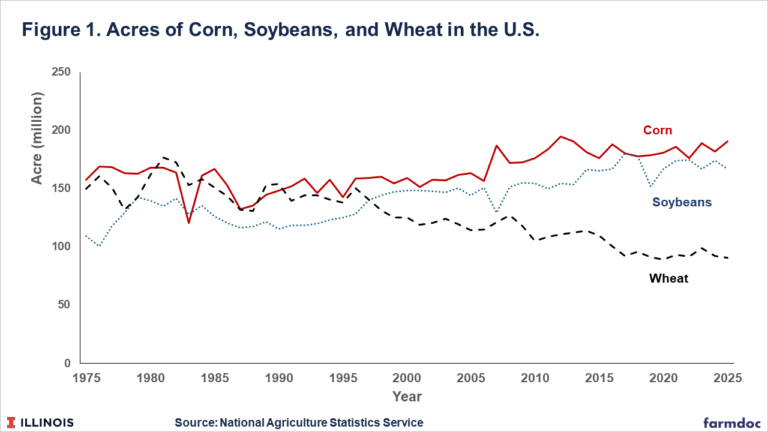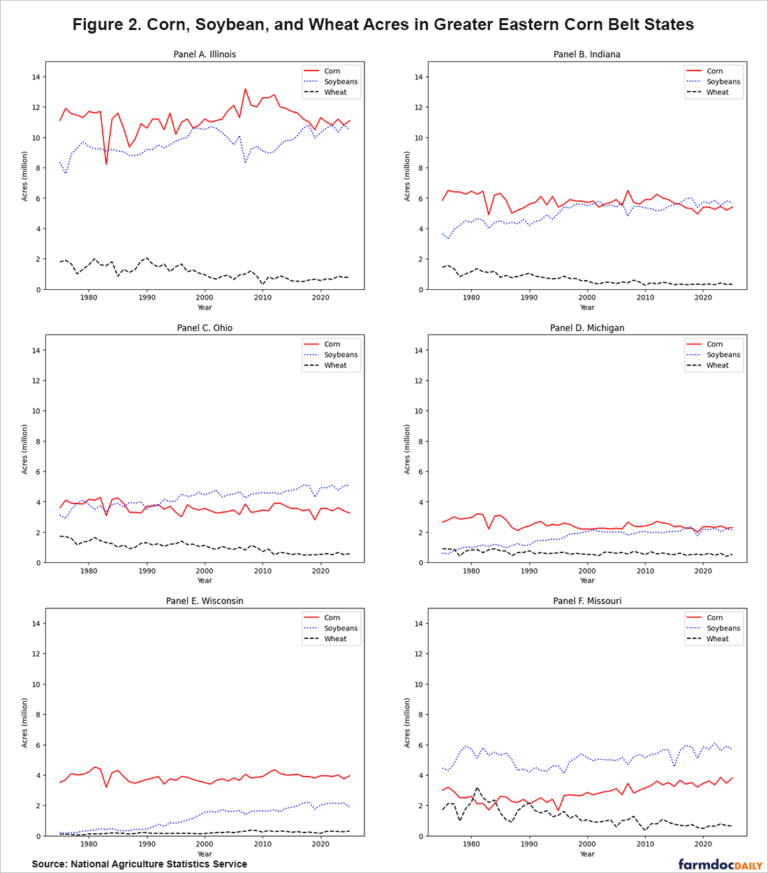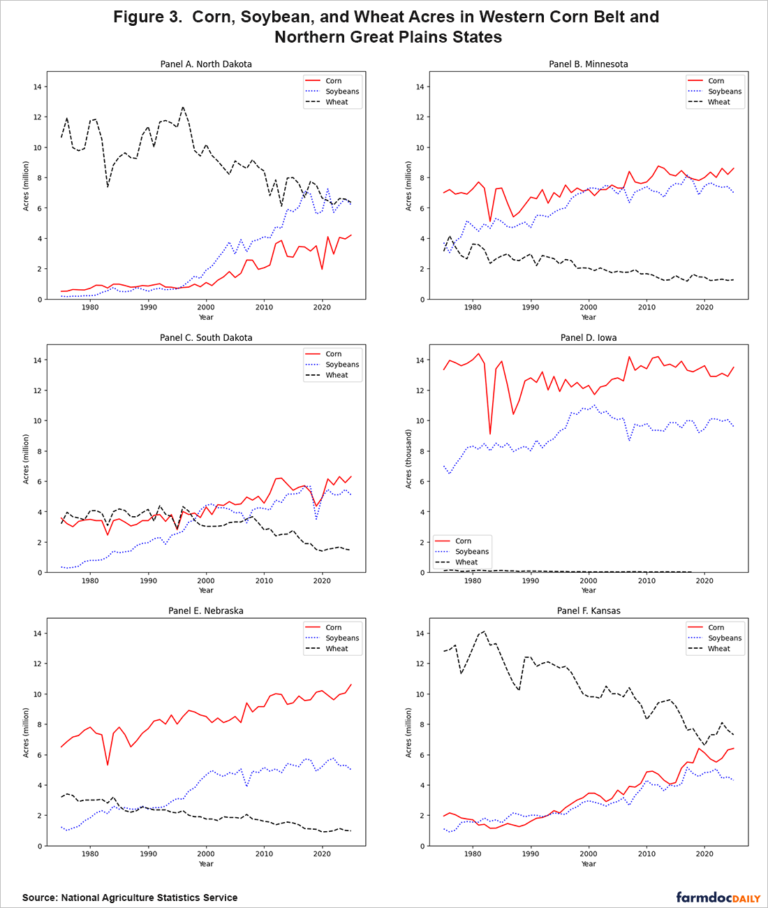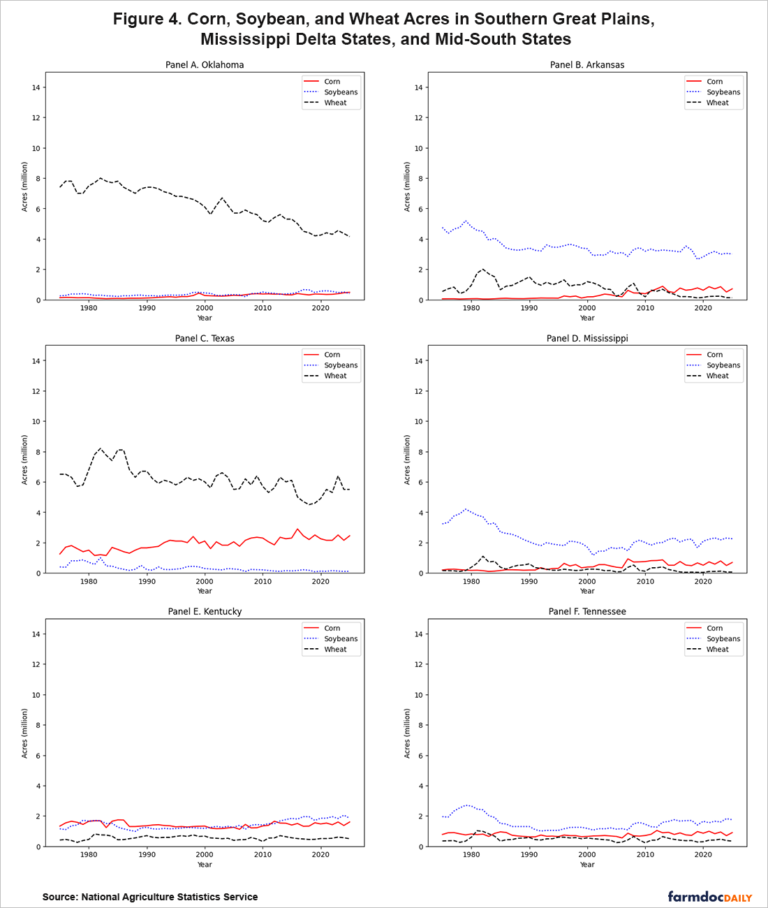By Gary Schnitkey and Nick Paulson et.al
The most recent Prospective Plantings report released by the U.S. Department of Agriculture suggests more corn acres and fewer soybean and wheat acres in 2025. Those changes are not the same across the United States. States in the western Corn Belt and Great Plains are expected to see the largest increases in corn acres: Iowa, Nebraska, South Dakota, and Minnesota. Changes in 2025 largely continue longer-term trends across the nation. Wheat acres continue to decline, particularly in the Great Plains. North Dakota through Kansas are tending to add both corn and soybean acres.
U.S. Trends
In 2025, U.S. farmers are projected to plant 95.3 million corn acres, an increase of 4.7 million acres from 2024. Soybean acres are projected at 83.5 million, down 3.6 million acres from the 2024 level. Wheat acres decreased from 46.1 million in 2024 to 45.4 million in 2025. Overall, acres are expected to shift towards corn and away from soybeans and wheat (see Figure 1).

Over time, wheat acres have declined in the U.S., with those acres moving to corn and soybeans. That switch began in earnest with the passage of the 1996 Farm Bill, which allowed farmers flexibility in plantings (farmdoc daily, March 3, 2025; March 28, 2025). That flexibility has allowed market conditions and expected profitability to more directly impact acreage decisions. Those acre shifts are not even across the U.S., as shown in the following sections detailing acre shifts by regions in the country.
Greater Eastern Corn Belt
Over time, states in the eastern Corn Belt have shifted more to soybeans with little or no change in corn acreage (see Figure 2). Since 1975, wheat acres have been relatively small in eastern Corn Belt states, but also have been declining.

Illinois: Illinois’ corn acres are projected at 11.1 million in 2025, a modest increase of 300,000 from 10.8 million in 2024 (see Panel A of Figure 2). Soybean acres are projected down by 300,000 acres to 10.5 million in 2025.
Overall, corn acres reached a high of 12.8 million in 2012, and soybeans were at 9.0 million that year. Since 2012, corn acres have declined, and soybean acres have increased. Corn and soybean acres have been close to one another in recent years in Illinois.
Indiana: Corn acres in Indiana are projected to increase by 200,000 to 5.4 million in 2025, while soybean acres are projected to decrease by 100,000 to 5.7 million.
Since 1995, corn and soybean acres have been close to one another in Indiana, with soybean acres exceeding corn acres since 2015 (see Panel B of Figure 2).
Ohio: Corn acres are projected to decline 150,000 to 3.25 million in 2025, while soybean acres are projected to increase slightly to 5.1 million.
Soybean acres have been increasing relative to corn acres in Ohio in recent years (see Panel C of Figure 2). Soybean acres have exceeded corn acres since 1990.
Michigan: Corn acres are projected at 2.3 million and soybeans at 2.15 million, both similar to acreage in 2024. Michigan has planted approximately the same number of corn and soybean acres for nearly a decade (see Panel D of Figure 2).
Wisconsin: In 2025, corn acres are projected at 3.95 million, while soybeans are at 1.9 million (see Panel E of Figure 2). Wisconsin has been increasing soybean acres over time, with many of these acres coming from alfalfa (Panel E of Figure 2). Wisconsin stands out from the eastern Corn Belt in its high reliance on corn that results from its dairy sector.
Missouri: In 2025, corn acres are projected at 3.8 million, while soybeans are at 5.7 million (see Panel E of Figure 2). Over time, Missouri has more acres in soybeans than in corn, unlike other Corn Belt states west of the Mississippi. Missouri has been gaining in both corn and soybean acres and losing wheat acres.
Western Corn Belt and Northern Great Plains
Notably, corn acres exceed soybean acres by wide margins in Iowa and Nebraska. States in the northern Great Plains have seen wheat acres decline while both corn and soybeans acres have increased. All states are projected to have more acres of corn in 2025.

North Dakota: In 2025, North Dakota is projected at 4.2 million corn acres (up 250,000 acres from 2024), 6.2 million soybean acres (down 400,000), and 6.36 million wheat acres (down 215,000). North Dakota has been losing wheat acres since 2000. Both corn and soybean acres are increasing (see Panel A of Figure 3).
Minnesota: In 2025, Minnesota is projected to plant 8.6 million corn acres (up 400,000 from 2024), 7 million soybean acres (down 400,000) and 1.26 million wheat acres (up 40,000). Wheat acres have declined over time. In recent years, corn acres have exceeded soybean acres (see Panel B of Figure 3).
South Dakota: In 2025, South Dakota is projected to plant 6.3 million corn acres (up 400,000 from 2024), 5.1 million soybean acres (down 350,00 acres), and 1.46 million wheat acres (down 60,000). Wheat acres have declined, and corn and soybean acres have increased over time in South Dakota (see Panel C of Figure 3).
Iowa: In 2025, Iowa is projected to plant 13.5 million corn acres (up 600,000 from 2024) and 9.6 million soybean acres (down 450,000). Iowa is predominately a corn and soybean state, with corn acres exceeding soybean acres in all years (see Panel D of Figure 3)
Nebraska: In 2025, Nebraska is projected to plant 10.6 million acres of corn (up 550,000 from 2024), 5.0 million of soybeans (down 300,000) and 0.97 million acres of wheat (down 30,000). Wheat acres have declined over time. Corn and soybean acres have increased, with corn acres exceeding soybean acres (see Panel E of Figure 3). Due to irrigation, Nebraska heavily relies on corn relative to soybeans.
Kansas: In 2025, Kansas is projected to plant 7.3 million wheat acres (down 300,000), 6.4 million corn acres (up 100,000), and 4.3 million soybean acres (down 230,000). Both corn and soybean acres have generally been trending up in Kansas over time. Wheat acres have declined dramatically (see Panel F of Figure 3).
Southern Great Plains, Mississippi Delta, and Mid-South States
The Southern Great Plains states have seen wheat acres decline over time. Acres have changed little in Mississippi Delta and Mid-South states.

Oklahoma: In 2025, Oklahoma is projected to plant 4.15 million acres of wheat (down 200,000 acres from 2024). Wheat acres have trended down over time (see Panel A of Figure 4).
Arkansas: In 2025, Arkansas farmers are projected to plant 3 million acres of soybeans, down slightly by 50,000 acres. Soybean acres have Increased over time in Arkansas (see Panel B of Figure 4)
Texas In 2025, Texas is projected to plant 5.5 million acres of wheat, the same as last year. Corn is projected at 2.45 million acres in 2025, up by 300,000 acres. Relatively modest changes in wheat, corn, and soybean acres have occurred in Texas over time (see Panel C of Figure 4).
Mississippi: Mississippi farmers are projected to plant 2.25 million soybean acres in 2025, similar to acreage in 2024 (see Panel D of Figure 4).
Kentucky: Corn acres are projected to increase from 1.37 million acres in 2024 to 1.6 million in 2025. Soybean acres are projected to decrease by 200,000 acre to 1.85 million in 2025. Over time, Kentucky’s corn and soybean acres have increased over time (see Panel E of Figure 4).
Tennessee: Soybean acreage in Tennessee is projected to be 1.8 million acres, a decrease of 70,000 acres from 2024 levels. Panel F of Figure 4 shows acreage of soybeans, corn, and wheat being relatively flat in Tennessee over the past 25 years.
Concluding Comments
More corn acres are projected to be planted in 2025 than in 2024. While many states are projected to increase corn acres, some of the largest increases occur in the western Corn Belt and Great Plains: Iowa increased 600,000 acres, Nebraska (550,000), Minnesota (400,000), South Dakota (400,000), Missouri (350,000). Those states also tend to have the largest soybean acre declines relative to 2024.
Changes in 2025 tend to continue longer-term trends. The western Corn Belt and Great Plains have increased corn acreage while losing wheat acres. Some of the higher corn concentrations occur in these states: Iowa and Nebraska. States in the eastern Corn Belt tend to plant about the same number of corn acres as soybean acres.
Source : illinois.edu